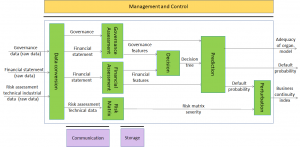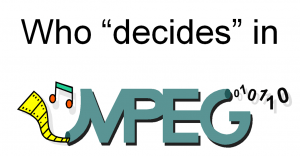Introduction
MPEG standards are great communication tools and MPEG itself is – or tries to be – a good communicator, of course using all available media.
This article is for those who want to be informed about MPEG, without having to digest one of its handy 500-page standards ?
MPEG web site
Almost everything that will be mentioned in this post can be found, not necessarily in an easy way, in the MPEG web page: press releases, MPEG column, video tutorials, White papers, investigations and technical notes, ad hoc groups, events, social networks, liaisons and meetings. The next meeting will be held at Marrakesh, MA from 14 to 18 January 2019
Press releases
Since its early days, MPEG took care of informing the world of its work. At the beginning this was done only on major occasions. Now MPEG does that systematically at every meeting. The news considered the most important news gets the headlines and all other achievements get a note. The rule is to mention in a press release all Calls for Evidence (CfE) and Call for Proposals (CfP), and the standards under development that reach the stage of Committee Draft (CD) or Final Draft International Standard (FDIS). News are prepared by the relevant group chairs, edited and distributed to the press by Prof. Christian Timmerer of University of Klagenfurt.
Let’s take as look at the press release from MPEG 124 (Macau SAR, CN) to have an example.
- The headline news is “Point Cloud Compression – MPEG promotes a video-based point cloud compression technology to the Committee Draft stage” because we believe this will be a very important standard.
- The second news is “MPEG issues Call for Proposals on Compressed Representation of Neural Networks”.
- Two video compression-related CfPs “MPEG issues Call for Proposals on Low Complexity Video Coding Enhancements” and “MPEG issues Call for Proposals for a New Video Coding Standard expected to have licensing terms timely available”
- News on “Multi-Image Application Format (MIAF) promoted to Final Draft International Standard”
- Anticipation of a new CfP “3DoF+ Draft Call for Proposal goes Public”.
The press release page containing all press release since January 2006 here.
If you want to be added to the distribution list, please send an email to Christian.
MPEG Column
When possible the news in the press releases have links to documents relevant to the news. We try to avoid links to the mythical 500-pages documents but clearly knowing more about a news item typically has a higher entry level.
With the MPEG column MPEG tries to be facilitate understanding of what its standards do. At every meeting, brief notes are published that explain the purpose and, to some extent, the working of MPEG standards.
Want to know about High Dynamic Range (HDR)? the Common Media Application Format (CMAF)? The new standard to view omnidirectional video (OMAF)? By going here you will see all articles published in the column and will have the opportunity to get answers to many questions on these and other MPEG standards.
The MPEG column is managed by the professional journalist Philip Merrill who is able to understand MPEG standards and explain them to the public.
Do you think an article on a particular standard would be of interest? Please send email to the chairman of the Communication Group Prof. Kyuheon Kim of Kyunhee University. We will do our best to satisfy your request.
Video tutorials
How could MPEG miss the opportunity to have its own series of “MPEG standards tutorials”, of course using its audio and video compression standards? By going to Video tutorials on MPEG standards you will be able to understand what MPEG has done to make its standards “green”, what is the Multimedia Preservation Application Format that manages multimedia content over the ages, what is the High Efficiency Video Coding (HEVC) standard, what is MPEG-H 3D Audio, what is MPEG Media Transport (MMT) used in ATSC 3.0, what is Dynamic Adaptive Streaming over HTTP (DASH) for audio-visual strteaming over the internet and much more.
The content is delivered by the best experts in the field. The videos that you see are the result of the shooting and post-processing performed by Alexis Tourapis.
White papers, investigations and technical notes
MPEG makes its best efforts to provide the smoothest entry path to its standards and several types of publicly accessible papers are functional to this strategy. White papers are published with the goal to
- Communicate that we are investigating some promising ideas as in Investigations about parts of standards
- Describe the purpose of an entire suite of standards, as in the case of White papers about standards or for a single part of a standard like in White papers about parts of standards
- Provide specific guidance about the use of standards as in Technical notes about parts of standards.
As a rule, the purpose of white papers is not to describe how the technology work but about what the standard is for, the problems it solves and the benefits that MPEG expects users will get by using it.
Investigations, White papers and Technical notes can be found here.
Standards
ISO is a private association registered in Switzerland. Standards are developed pro bono by participants in the working groups, but the cost of the organisation is covered by the sale of standards and other sources. Therefore you should not expect to find ISO standards on the public MPEG web page. If you need a standard, you should go to the ISO web site where your can easily buy online all the standards on sale. In some cases, MPEG requests ISO to make standard public because the standards is particularly relevant or because the standard is already publicly available (as is the case of all standards developed jointly with ITU-T).
MPEG posts all public documents at Standard documents from the last meeting, e.g. Use cases, Requirements, Calls for Evidence, Calls for Proposals, Working Drafts up to Committee Drafts, Verification Test results and more. MPEG does this because it wants to make sure that the industry is aware of, can comment on, and contribute to what to develop standards.
Ad hoc groups
Since 1990 MPEG has created ad hoc groups (AHG). According to the rules “AHGs are established for the sole purpose of continuing work between consecutive MPEG meetings”, but they are a unique way to have work done outside MPEG meetings in a coordinated way. The scope of an AHG, however, is limited by the rule: “The task of an AHG may only cover preparation of recommendations to be submitted to MPEG”.
AHGs are not permanent organisations but established at the end of a meeting to last until the following meeting, To have a feeling of what AHGs are about you can see the AHGs established at 124th MPEG meeting.
AHGs are mentioned as part of MPEG communication because anybody can join the email reflector of an AHG and even attend AHG meetings.
MPEG events
In certain cases, MPEG organises events open to the public. Some events are held during and co-located with an MPEG meeting, but events outside MPEG meetings are also held. These are some of the goals an MPEG event can have:
- To present a particular standard under development or just released as in Workshop on MPEG-G (Shenzhen, October 2018)
- To introduce the MPEG workplan such as MPEG Workshop on Immersive Services Roadmap (Gwangju, January 2018)
- To demonstrate what the industry is doing with an MPEG standards such as OMAF Developers’ Day (Gwangju, January 2018)
- To frame a particular segment of the MPEG activity in the general context of the industry such as Workshop on 5G/ Beyond UHD Media (La Jolla, February 2016).
Reference software and conformance
MPEG standards can be made public by a decision of the ISO Central Secretariat. MPEG requests ISO to make all reference software and conformance standards publicly available. The rationale of this request is that if developers look at the reference software, they need to buy the standard to make a conforming implementation. To create a healthy ecosystem of interoperable products, services and applications – the conformance testing suites, too, must make freely available. This entices more users to buy the standard.
Social networks
MPEG has a Twitter account @MPEGgroup (https://twitter.com/mpeggroup). This is used by a group of MPEG social champions to spread information on the currently hottest MPEG topics: MPEG-I Requirements, Neural Network Compression, MPEG-G, OMAF, File format, Network Based Media Processing, MPEG-I Visual (3DoF+ and 6DoF), Audio, Point Cloud Compression, Internet of Media Things.
Please subscribe to receive brief notes on MPEG-related news and events.
Liaisons
MPEG develops standards technologies that are used by many industries all over the world. MPEG requests to liaise with many standards committees and industry fora for several purposes: to get use cases and requirements, to jointly develop standards, to promote adoption of the standard once it has been developed and to receive further requests for new functionalities.
These are some of the organisations MPEG has liaisons with: the Third Generation Partnership Project (3GPP), Advanced Television Systems Committee, Inc. (ATSC), Internet Engineering Task Force (IETF), Society of Motion Picture and Television Engineers (SMPTE), Audio Engineering Society (AES), European Broadcast Union (EBU), Hybrid Broadcast Broadband TV (HbbTV), Society of Cable Telecommunications Engineers (SCTE), World Wide Web Consortium (W3C) and many more.
Administrative documents
At every meeting MPEG publishes several documents – that I call “administrative” for lack of a better name – but are very important because they include organisational information. The following documents relate to MPEG 124 (Macau SAR, October 2018):
- list of ad hoc groups established at the meeting
- call for patents related to standards under development
- list of MPEG standards produced since day 1 and those planned
- MPEG work plan with a summary description of all activities under way including explorations
- MPEG timeline with planned dates of development of all standard
- MPEG terms of reference
- MPEG schemas
- MPEG URIs.
Conclusions
MPEG is fully aware of the social and industrial implications of its standards. This post conveys the MPEG policy of being open to the world, to the extent that ISO rules allow.
Posts in this thread (in bold this post)
- The MPEG ecosystem
- Why is MPEG successful?
- MPEG can also be green
- The life of an MPEG standard
- Genome is digital, and can be compressed
- Compression standards and quality go hand in hand
- Digging deeper in the MPEG work
- MPEG communicates
- How does MPEG actually work?
- Life inside MPEG
- Data Compression Technologies – A FAQ
- It worked twice and will work again
- Compression standards for the data industries
- 30 years of MPEG, and counting?
- The MPEG machine is ready to start (again)
- IP counting or revenue counting?
- Business model based ISO/IEC standards
- Can MPEG overcome its Video “crisis”?
- A crisis, the causes and a solution
- Compression – the technology for the digital age
- On my Charles F. Jenkins Lifetime Achievement Award
- Standards for the present and the future


